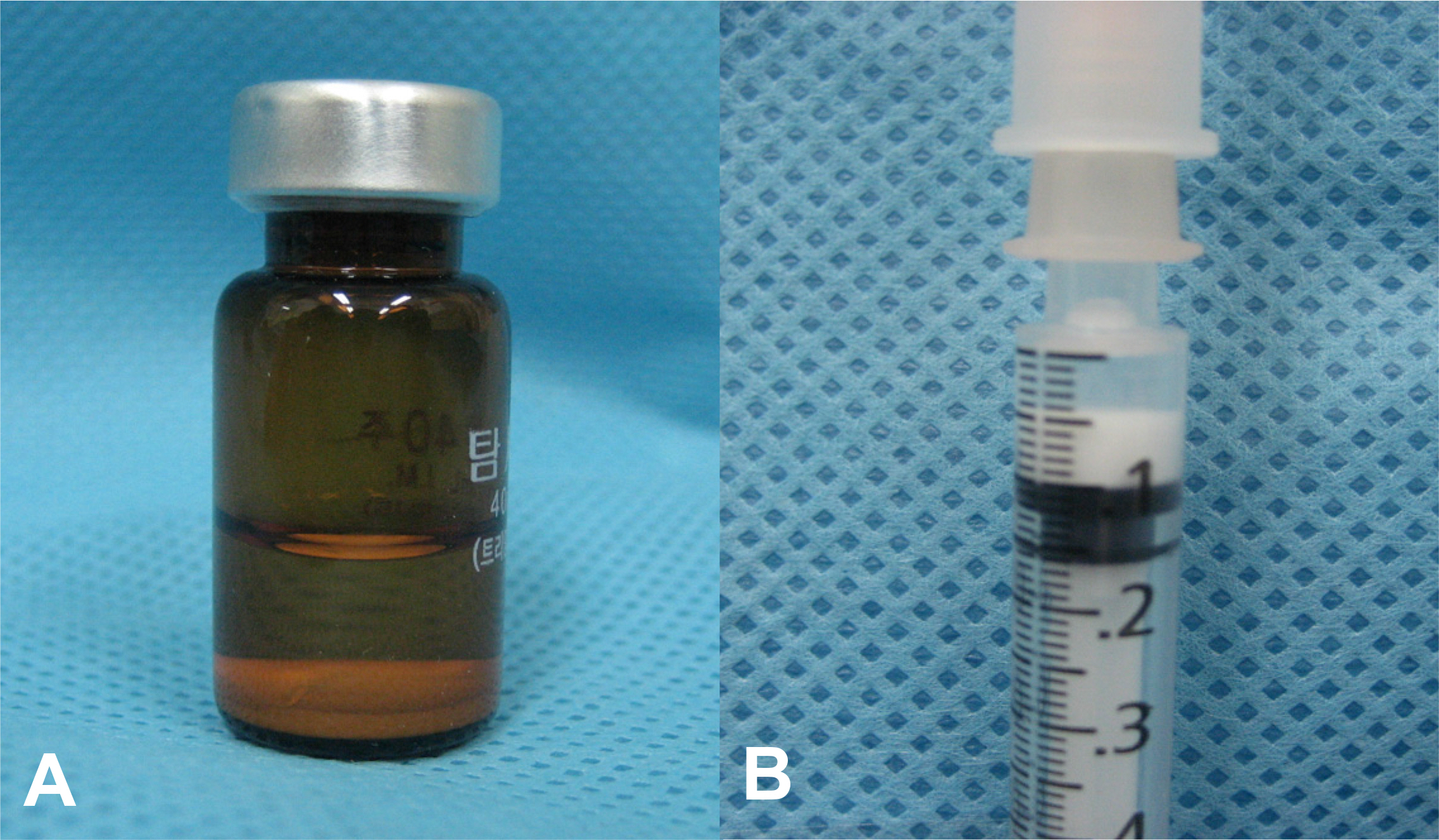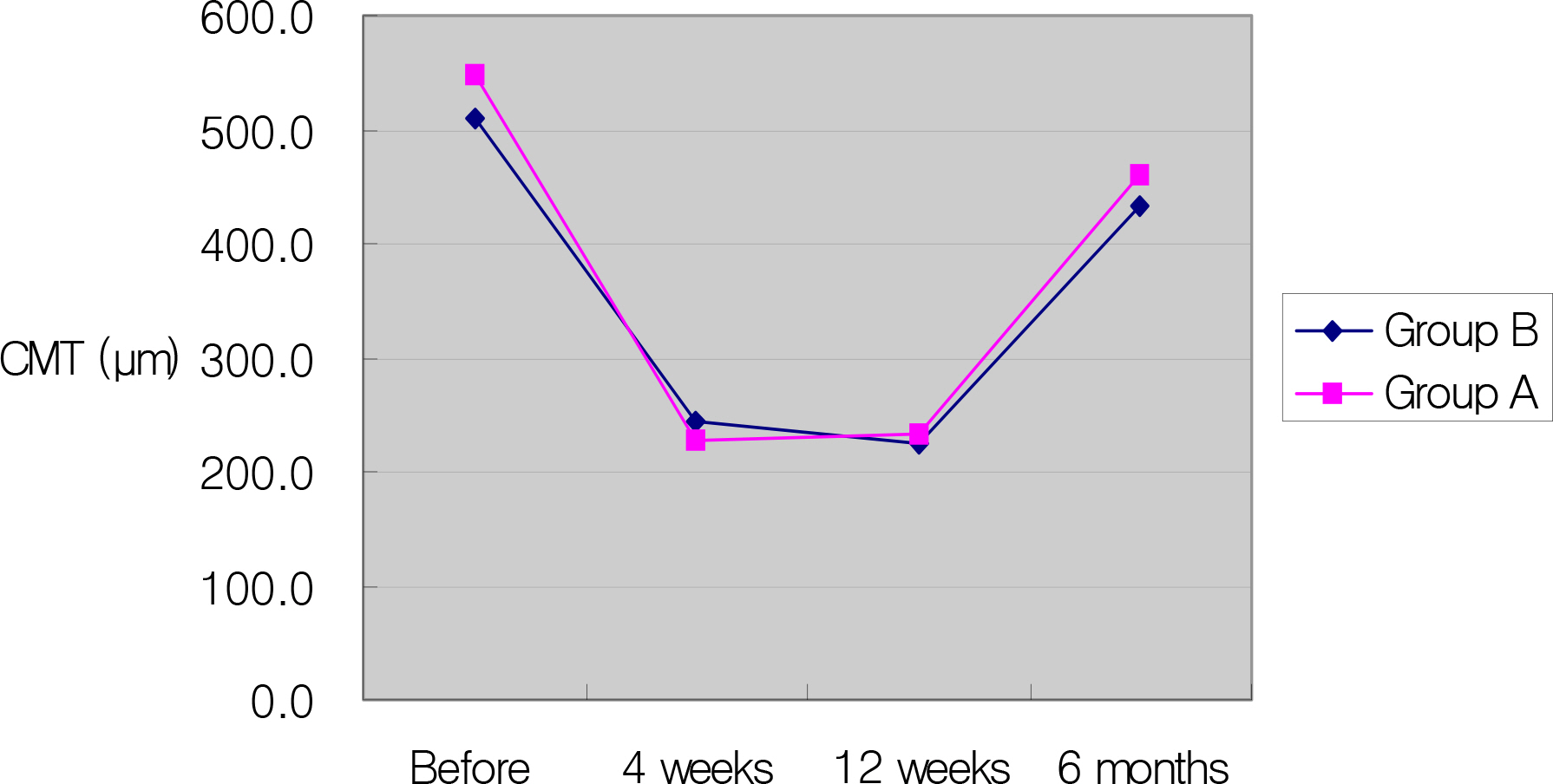J Korean Ophthalmol Soc.
2008 Apr;49(4):589-594. 10.3341/jkos.2008.49.4.589.
Intraocular Pressure Elevation After Intravitreal Triamcinolone Acetonide of Different Volumes: Comparing 0.1 ml vs 0.05 ml
- Affiliations
-
- 1Department of Ophthalmology, Soonchunhyang University, College of Medicine, Seoul, Korea. ckseek@naver.com
- KMID: 2211489
- DOI: http://doi.org/10.3341/jkos.2008.49.4.589
Abstract
-
PURPOSE: To assess whether a 4 mg/0.05 ml intravitreal triamcinolone acetonide injection can reduce the IOP elevation compared to conventional 4 mg/0.1 ml injection.
METHODS
A retrospective case study was performed in 48 patients (48 eyes) who received intravitreal triamcinolone acetonide injection and who had a minimum follow-up time of six months. Patients were randomly assigned to receive 4 mg/0.1 ml or 4 mg/0.05 ml (24 patients in each group).
RESULTS
Before injection, mean IOP was 13.8+/-2.2 mmHg and 13.9+/-2.4 mmHg in the 0.1 ml and 0.05 ml group. The difference in IOP elevation between the two groups was statistically significant immediately after injection (P=0.000), one hour after injection (P=0.001), and one day after injection (P=0.000). After injection, the central macular thickness decreased significantly the of two groups. The difference of the central macular thickness decrease between both groups was not statistically significant.
CONCLUSIONS
An intravitreal triamcinolone acetonide 4 mg/0.05 ml injection will more quickly reduce the IOP elevation in the early phase compared to 4 mg/0.1 ml injection, while providing a similar effect on the change of central macular thickness.
Keyword
MeSH Terms
Figure
Cited by 2 articles
-
The Change of Anterior Chamber Parameters with Pentacam® after Intravitreal Injection
Byoung Seon Kim, Che Ron Kim, Seong Jae Kim, Yong Seop Han, Seong Wook Seo, Ji Myung Yoo, In Young Chung, Jong Moon Park
J Korean Ophthalmol Soc. 2013;54(12):1824-1831. doi: 10.3341/jkos.2013.54.12.1824.Semi-automatic Measurement of Ocular Volume from Facial Computed Tomography and Correlation with Axial Length
Junkyu Chung, In Ki Park, Samjin Choi, Jae-Ho Shin
J Korean Ophthalmol Soc. 2019;60(3):210-216. doi: 10.3341/jkos.2019.60.3.210.
Reference
-
References
1. Machemer R, Sugita G, Tano Y. Treatment of intraocular proliferations with intravitreal steroids. Trans Am Ophthalmol Soc. 1979; 77:171–80.2. Danis RP, Ciulla TA, Pratt LM, Anliker W. Intravitreal triamcinolone acetonide in exudative age‐ related macular degeneration. Retina. 2000; 20:244–50.3. Moshfeghi DM, Kaiser PK, Scott IU, et al. Acute endophthalmitis following intravitreal triamcinolone acetonide injection. Am J Ophthalmol. 2003; 136:791–6.
Article4. Wingate RJ, Beaumont PE. Intravitreal triamcinolone and elevated intraocular pressure. Aust N Z J Ophthalmol. 1999; 27:431–2.5. Jonas JB, Kreissig I, Degenring R. Intraocular pressure after intravitreal injection of triamcinolone acetonide. Br J Ophthalmol. 2003; 87:24–7.
Article6. Özkiris A, Erkilic K. Complications of intravitreal injection of triamcinolone acetonide. Can J Ophthalmol. 2005; 40:63–8.7. Yang YH, Kim KR, Yang SW, Yim HB. The effect of intravitreal triamcinolone acetonide on intraocular pressure. J Korean Ophthalmol Soc. 2004; 45:1081–5.8. Smithen LM, Ober MD, Maranan L, Spaide RF. Intravitreal triamcinolone acetonide and intraocular pressure. Am J Ophthalmol. 2004; 138:740–3.
Article9. Bakri SJ, Beer PM. The effect of intravitreal triamcinolone acetonide on intraocular pressure. Ophthalmic Surg Lasers Imaging. 2003; 34:386–90.
Article10. Park HY, Yi K, Kim HK. Intraocular pressure elevation after intravitreal triamcinolone acetonide injection. Korean J Ophthalmol. 2005; 19:122–7.
Article11. Jonas JB, Kreissig I, Degenring R. Secondary chronic open angle glaucoma after intravitreal triamcinolone acetonide. Arch Ophthalmol. 2003; 121:729–30.12. Gilles MC, Simpson JM, Billson FA, et al. Safety of an intravitreal injection of triamcinolone:results from a randomized clinical trial. Arch Ophthalmol. 2004; 122:336–40.13. Audren F, Lecleire‐ Collet A, Erginary A, et al. Intravitreal triamcinolone acetonide for diffuse diabetic macular edema: phase 2 trial comparing 4 mg vs 2 mg. Am J Ophthalmol. 2006; 142:794–9.
Article14. Baath J, Ells AL, Crichton A, et al. Safety profile of intravitreal triamcinolone acetonide. J Ocul Pharmacol Ther. 2007; 23:304–10.
Article15. Heatley CJ, Lim KS, Siriwardena D, Barton K. Malignant glaucoma as a complication of intravitreal triamcinolone acetonide. Acta Ophthalmol Scand. 2006; 84:712–3.
Article
- Full Text Links
- Actions
-
Cited
- CITED
-
- Close
- Share
- Similar articles
-
- The Effect of Intravitreal Triamcinolone Acetonide and Bevacizumab Injection on Intraocular Pressure
- Intraocular Pressure Change After Secondary Intravitreal Triamcinolone Acetonide Injection
- Clinical Manifestations of Intraocular Pressure Elevation after Intravitreal Injection of Triamcinolone Acetonide
- The Comparison of Intraocular Pressure Elevation after Intravitreal Injection of Different Concentration of Triamcinolone Acetonide
- The Intraocular Pressure Rise Secondary to Subtenon's Injection of Triamcinolone After Intravitreal Injection




